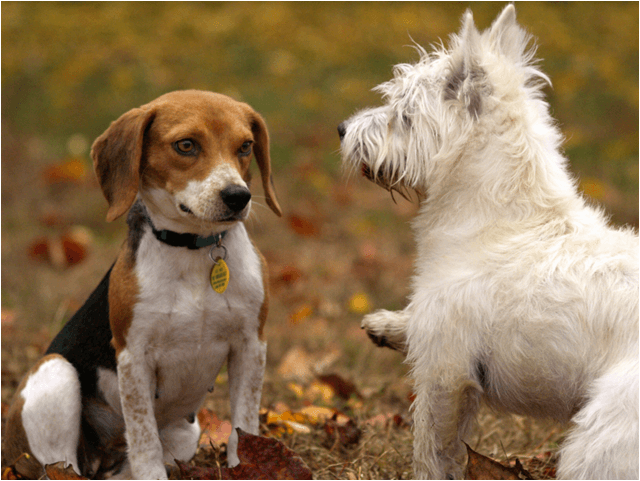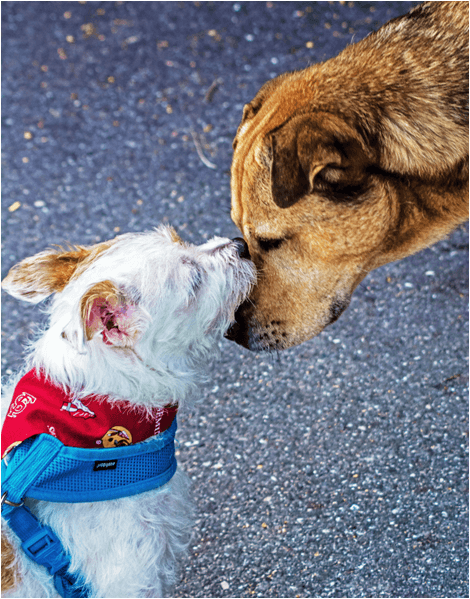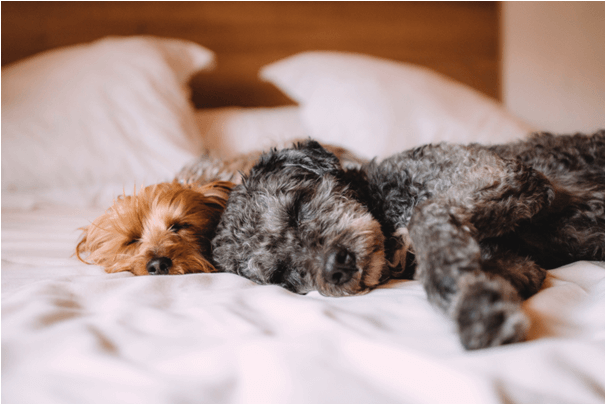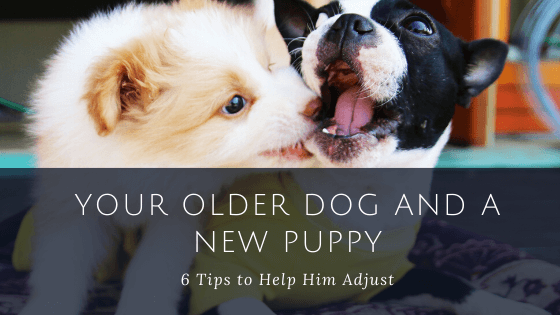Disclosure: My dog blog is supported by dog parents just like you. I only recommend products that I would use on my dogs. All opinions expressed here are my own. I sometimes earn a small affiliate commission, at no extra cost to you, when you click through the affiliate link and purchase something. You can read more about my affiliate policy here.
A new puppy is a fun and exciting addition to the family. However, if your family already has an older four-legged member or two, understand you will need to put in some extra preparation to help your older dogs adjust appropriately. In the beginning, the best decision you can make is realizing that your older dogs are not going to accept the new family member as excitedly as you. However, your older dog can adjust to a puppy in the family when you help out using the 6 tips in this post!

You and your older dog have an established routine that, now, suddenly is spinning in every direction, with the energy a puppy has brought into your family. So, your older dogs will struggle with no longer being the center of attention. They will be irritated with having their ears and tails nipped at, or being pounced on during a nap. Then, there is the fact that the puppy doesn’t have social skills, or an understanding of what belongs to whom. So, the older dogs will be annoyed at their food, treats, favorite toys, and even their beds being stolen.
Regardless, your ultimate goal is to have one big, happy family of humans and dogs alike; so, the second best decision you can make is to understand the situation from your established dogs’ perspective and help them maintain a sense of order. By doing this, you will minimize the disruption and anxiety your senior dogs are experiencing with having a new family member. In addition, here are the 6 tips so your older dog can adjust to a puppy as a family member.
6 Tips So Your Older Dog Can Adjust to a Puppy
1. Don’t punish your older dog or dogs
Understand it’s completely natural for your older dog to feel unsettled, jealous, or threatened by the presence of a puppy that gets all the attention. It is also natural for him to growl at the puppy for stealing food or being too annoying. Keep in mind, your older dog is teaching the puppy boundaries and how to behave; and you do not want to disrupt the teaching and learning that’s happening to make a happy family..
2. Make sure each dog has his own resources

Separate food, water, beds, and toys should be provided for each dog. It will help them to get along if they have their own things. Give the puppy his own toys, and praise him for choosing to play with them over his older brother or sister’s toys. Be sure to distract him from playing with your older dog’s favorite toys. Always tell him “no”, remove the toy, and return it to your older dog.
Food is another important separation. Mainly for the fact that your older dog and your puppy are at different stages of their life and need the benefits that food developed for each stage provides. Puppy food has three times the calories of adult food with fat and protein. This extra fat and protein can tax the kidneys of an older dog.
On the flip side, the puppy needs the extra calories from fat and protein to ensure proper growth and your aging dog needs the extra vitamins and nutrients his food provides. So, make sure you not only feed them different food in their separate bowls, but have separate spaces for them to eat. Pick up both bowls when they are finished. It is recommended by most veterinarians to feed a dog twice a day, instead of filling a bowl to the top and letting your dog eat from it all day. You need to check with your veterinarian as to how often and how much to feed your new puppy and your older dog.
3. Acknowledge your Older dog ahead of the puppy
Be sure to continue to give your older dog the same love and attention you offered him before the puppy joined the family. All animals have a pecking order. It’s essential your older dog keeps his fur-family place preserved. You will have happier dogs if they know and understand their place in the pecking order. You can help with this by putting your older dog’s needs first and the puppy’s second. When you come home from work, greet your older dog first. A few other ideas: let your older dog go through doors first, feed him first, and put his leash on first when going for a walk. This balance will ensure a better relationship between the two.
4. Keep your older dog in his routine
Your older dog finds change hard to deal with. Dealing with the new puppy is the only change he needs to deal with. You will only make things more challenging for him if you disrupt his routine. His normal schedule helps keep his day in order and gives him a sense of security. It will also reduce any resentment he might be harboring for his new brother or sister.
5. Give your Older dog alone time with you
Just like an adult needs a break from time to time from an energetic child, an older dog needs a break from an energetic puppy. Create “mommy and me” or “daddy and me” time with your older dog. By doing this, you are giving your older dog security that he is not being replaced by the puppy and your bond with him is being refreshed. This also gives him a safe space away from the annoying puppy. Your older dog will find his patience for the puppy restored. He will also feel more like accepting the puppy.
6. Use a reward-based training method
This goes for both the new puppy and your older dog. You are training the puppy on everything, so it is natural to reward him when he does it right. However, you also need to be training your older dog’s behavior toward the new puppy and rewarding him when he uses appropriate coping strategies, such as getting up and moving away from the puppy, rather than growling. Be observant to encouraging signs that your older dog is accepting the puppy, such as engaging in play, or wagging his tail when the puppy approaches him.
Concluding…

Yes, adding a new puppy is fun and exciting! With these 6 tips and giving the right amount of love and attention to all of the dogs, while being mindful of their interactions, you will be well on your way to achieving your ultimate goal of having one big, happy family of humans and dogs alike.
Let us know if you have any other tips that can help an older dog adjust to the addition of a new puppy.
We recommend this post on socializing your new puppy. If you love looking at photos of adorable puppies, check out this post by The American Kennel Club. We also have an awesome dog gallery to browse dog photos.
You can use the following images to pin to Pinterest.




